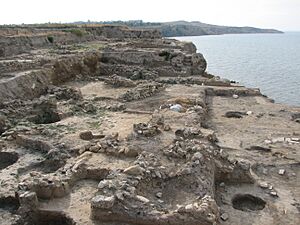Archaeology of Russia facts for kids
Russian archaeology is the study of ancient people and their lives in the lands that are now Russia. Archaeologists dig up and examine old objects, buildings, and settlements to understand history. This field began in the Russian Empire around the 1850s. Later, in the early 20th century, it became known as Soviet archaeology. A special magazine called Sovetskaya arkheologiya (Soviet Archaeology) has been published since 1957.
Contents
Exploring the Past: Archaeologists
Archaeologists are like detectives of the past. They carefully dig at sites to uncover clues about how people lived thousands of years ago. Many talented people have worked in Russian archaeology. They have helped us learn about ancient cultures and civilizations that once thrived in this vast country.
Amazing Ancient Sites

- Further information: Kurgan and Eurasian nomads
Russia is home to many incredible archaeological sites. These places show us how different groups of people lived, hunted, farmed, and built their homes. An "archaeological culture" is a group of sites and artifacts that are similar, suggesting they were made by the same group of people over time.
Here are some major archaeological cultures and sites found in Russia:
Stone Age Discoveries
- Kermek and Bogatyri/Sinyaya Balka: These are very old sites that show us where some of the earliest humans lived.
- Kostyonki and Sungir: These sites are famous for their amazing finds from the Stone Age, including ancient human remains and tools.
- Yana RHS: This site is important for understanding life in the far north during the Ice Age.
- Afontova Gora: Another key site from the Upper Paleolithic period.
- Mal'ta–Buret' culture: This culture from the Upper Paleolithic is known for its unique art and settlements.
Bronze Age Civilizations
- Khvalynsk culture (Eneolithic): This culture marks a time when people started using copper.
- Fatyanovo–Balanovo culture (Chalcolithic): Another early metal-using culture.
- Novotitorovka culture and Maykop culture: These cultures from the Early Bronze Age are known for their rich burial mounds, like the famous Maykop kurgan.
- Yamna culture and Afanasevo culture: These were widespread Early Bronze Age cultures, often associated with nomadic lifestyles.
- Abashevo culture: A significant Bronze Age culture.
- Andronovo culture: This Middle to Late Bronze Age culture built impressive settlements like Arkaim and Sintashta. These sites show early forms of urban planning and metalworking.
- Srubna culture: This culture existed from the Late Bronze Age into the Iron Age.
Iron Age and Medieval Settlements
- Tanais: An ancient city that existed from the Late Bronze Age into the Iron Age.
- Pazyryk culture: This Iron Age culture is famous for its well-preserved burials in the Altai Mountains, including textiles and wooden objects.
- Tmutarakan: An important medieval city on the Black Sea coast.
- Staraya Ladoga: This site was a key trading hub during the Viking Age.
- Rurikovo Gorodische and Gnyozdovo: These were important early medieval settlements, showing connections to the Viking world.
- Sarkel: A fortress from the 9th century, showing early medieval architecture.
See also
- History of archaeology
- History of Russia
- History of Central Asia
- Scythia
- Kurgan hypothesis
- List of Russian historians

